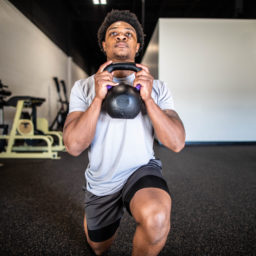When it comes to strength training we all have weak links whether we want to admit it or not. Identifying these weaknesses and fixing them is the difference between an average novice lifter and a seasoned lifter.
It is what gets you though plateus and puts more weight on the bar. It is also what keeps you in the game longer and prevents injuries from appearing.
The quicker you figure this out and start addressing your weak links the better performing and resilient you will be.
What is weak link training?
Weak link training is a way of preventing injuries and eliminating potential weaknesses in your movement mechanics. This is done by targeting specific joint stabilizing muscles in-order to give them much needed attention they do not get in the bigger compound movements. This prevents injuries by producing a well-balanced musculature, thus evenly distributing forces throughout our bodies.
Weak link training allows for rapid gains and having access to your true strength potential. A lifting career without weak link training is like a high-powered sports car never going into the shop for routine maintenance. You keep up with the maintenance your car lasts longer and performs better. If you get lazy, you end up broken down on the side of the road trying to figure out what to do next.
Why should I train my weak links?
When liftin heavy weights every muscle involved with that movement must fire. If any muscle along the chain is not performing to full capacity it will result in compensation. Our bodies are always compensating, but excessive compensation leads to chronic overuse injuries and muscle imbalances.
The trends for most people in commercial gyms is to make steady gains in their workouts, but at some point they hit a wall in progression. They start experiencing little twinges here and there but deduce it to age or growing pains. Their body has compensated all it will allow and is neurologically inhibiting them from adding any more weight. This is a protective mechanism the brain has evolved to spare ourselves from self destruction. This can be overridden though with a strong enough will power; if this is the case you are jumping down a rabbit hole straight to injury.
Strength for a large part of the beginning stages are pure neurological changes. If these changes are happening with dramatic compensation you are teaching your body bad movement mechanics. It can be a very discouraging and daunting project to relearn movement patterns after bad ones have been ingrained. If this is the case most likely you’ve already slipped down the rabbit hole and you’re in some physical therapist office. It is best to take your time and make sure it doesn’t happen to begin with. This can be done by strategically implementing weak link training. This training can range from an entire workout dedicated to weak links, a pre-workout warmup, or even a post workout burnout circuit.
How do I do it?
Below I have included each major complex joint in the body with key stabilizers and how to strengthen them. There are a couple ways you can use these exercises.
Warm up
After doing some foam rolling and mobility drills you can implement a handful of these exercises as activation drills for the workout of the day.
Sticking with 1-2 sets of 10-20 reps works fine depending on the exercise. Remember the goal is to activate not pre exhaust as this will take away from the main lift.
Burnout circuit
At the end of a workout choose exercises that hit key stabilizers of your main lifts of the days. Put them in a circuit and work to failure. This will make sure you have exhausted these key muscles for sure muscle growth and strength. 2-3xfailure
Recovery day
My personal favorite. On an active recovery day pick some muscles you know you are lagging in and add them to a circuit. Perform after some foam rolling and stretching for 1-3 sets leaving 2-3 reps left in the tank to avoid turning a recover day into a full workout. Do not lose track of goal to achieve good activation, but to recover from your intense workout sessions.
Feet/ankles
Key stabilizers:
intrinsic foot muscles, gastrocnemius, soleus, anterior tibialis
Strengthening exercises:
3 point drill- works the intrinsic muscles of the feet [pic]
Toe splay- another drill for the intrinsic muscles[pic]
Squat calf raise- strengthens the soleus and gastrocnemius[pic]
Single leg calf raise- strengthens the soleus and gastrocnemius[pic]
Anterior tibialis raises- strengthens anterior tibialis [pic]
Knees
Key stabilizers:
Quads, hamstring, glutes
Strengthening exercises:
Terminal knee extensions (TKE)- strengthens the quads specifically the Vastus medialis a key patellar stabilizer.
Single leg elevated glute raise- strengthens hamstring and glute
Banded side steps- strengthens glutes
Hips
Key stabilizers:
Hip flexor group, hamstrings, glutes, adductors, lower back muscles
Strengthening exercises:
Banded lying hip flexion- strengthens hip flexors [pic]
Banded side step- strengthens glutes[pic]
Lying single foot elevated glute raise- strengthens hamstrings and glutes[pic]
Lying 3 position block squeeze- strengthens adductors[pic]
Supermans- strengthens lower back muscles[pic]
Shoulders
Key stabilizers:
Rotator cuff group, trapezius, rear delts
Strengthening exercises:
I,Y,T raises- Trapezius
Cable or band external rotation- rotator cuff group and rear delts
Hanging retraction drill- trapezius group
Dumbbell shrugs- trapezius group
Rear delt fly- rear delt
Face pull- Rotator cuff group, trapezius, rear delts
Neck
Key stabilizers:
Too many to name. Goal is to strengthen the major movement patterns of the neck especially for people who do a lot of heavy lifting and overhead work. Will not go into a lot of detail in this article. If you would like to know more neck strengthening exercises comment and I will write an article about neck strengthening.
Strengthening exercises:
Lying flexion circuit
Lying extension circuit
Banded rotation
Plate side bend


